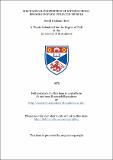Files in this item
Mechanical properties of myosin cross-bridges in frog striated muscle
Item metadata
| dc.contributor.advisor | Flitney, F. W. | |
| dc.contributor.advisor | Stephens, William George Sinclair | |
| dc.contributor.author | Hirst, David Graham | |
| dc.coverage.spatial | 130 p. | en_US |
| dc.date.accessioned | 2018-07-03T08:58:18Z | |
| dc.date.available | 2018-07-03T08:58:18Z | |
| dc.date.issued | 1975 | |
| dc.identifier.uri | https://hdl.handle.net/10023/14825 | |
| dc.description.abstract | A. A study has been made of the tension responses and relative sliding movements of the actin and myosin filaments which result when controlled length changes of variable amplitude and velocity are applied to contracting frog's muscle. B. The tension increment produced by a 'ramp and hold' stretch of approximately 1mm (about 4 % of muscle length) consists of three phases whose limits are defined by two points, designated S1 and S2, where the slope of the increase of tension changes abruptly. S1 and S2 correspond with muscle extensions of 40-45 mum and 325 - 375mum, respectively. C. Displacement of the actin and myosin filaments was recorded simultaneously by monitoring changes in the diffraction spectra produced by illuminating a small area of muscle with a laser. The spectra were projected onto a screen and photographed with a cine-camera. The spacing of the 1st order lines was measured and used to calculate sarcomere length. D. Cine photography of diffraction spectra showed that a variable, and sometimes large, proportion of the length change applied to the muscle is taken up by extension of elastic elements arranged in series with the sarcomeres. During the early part of the stretch, filament displacement is less than would be anticipated if all of the external length change was distributed uniformly amongst the sarcomeres. E. The way in which sarcomeres shorten during the onset and development of an isometric tetanus shows that the series elastic elements become progressively stiffer with increasing extension; at peak tetanic tension their compliance is found to be approximately 6.5 x 10-4m.N-1. F. When the actin and myosin filaments are forcibly displaced by about 11-12nm from their 'steady state' position at the peak of an isometric tetanus, the sarcomere length increases abruptly by some 20- 30nm, a phenomenon referred to as rapid 'give'. The 11-12nm displacement before rapid 'give' occurs, represents the range of movement of the filaments over which the myosin cross-bridges can be distorted yet remain attached to the actin active site. This range of movement is found to be independent of sarcomere length, and hence, of interfilamentary spacing. Crossbridges are bridges are forcibly broken when the filaments are made to move by more than 11-12nm. The sudden increase in compliance of the sarcomeres which results effects an abrupt shortening of the stretched elastic elements (elastic recoil) at the expense of the sarcomeres in series with them, producing rapid 'give'. G. The stiffness of the sarcomeres and the force they are able to bear immediately prior to rapid 'give' (the maximum 'holding' force, designated Ps2) both directly proportional to filament overlap. Hence, the stiffness of an individual cross-bridge and its affinity for the actin active region are quantities which must be independent of the surface-to-surface separation of the filaments. The minimum stiffness of a single cross-bridge is estimated to be around 2.7 x 10-4 N.m-1. H. Tension changes and sarcomere movements during single and double cycles of stretch and release were recorded. The events occurring during a second cycle stretch differ markedly from those during a first. Cross-bridges can accommodate a wider range of filament movement without detaching , 18 nm as compared with 12 nm, if the second stretch is applied without delay after the proceeding release. The stiffness of the sarcomeres is approximately the same for a second cycle stretch ( 5.3 x 1012N.m-2 per metre extension of each half sarcomere) as for a first (5.95 x 1012N. 9 m-2 per metre extension of each half sarcomere), indicating that the number of cross-bridges holding the filaments together is not altered appreciably. These results are compatible with Huxley & Simmons recent model. They suggest an actin active region of length 15 nm, made up of four regularly spaced (~5.0 nm separation) attachment sites, corresponding with individual actin monomers. | en_US |
| dc.language.iso | en | en_US |
| dc.publisher | University of St Andrews | |
| dc.subject.lcc | QP321.H5 | |
| dc.subject.lcsh | Muscles | en |
| dc.title | Mechanical properties of myosin cross-bridges in frog striated muscle | en_US |
| dc.type | Thesis | en_US |
| dc.contributor.sponsor | James McKenzie research fellowship | en_US |
| dc.type.qualificationlevel | Doctoral | en_US |
| dc.type.qualificationname | PhD Doctor of Philosophy | en_US |
| dc.publisher.institution | The University of St Andrews | en_US |
This item appears in the following Collection(s)
Items in the St Andrews Research Repository are protected by copyright, with all rights reserved, unless otherwise indicated.

